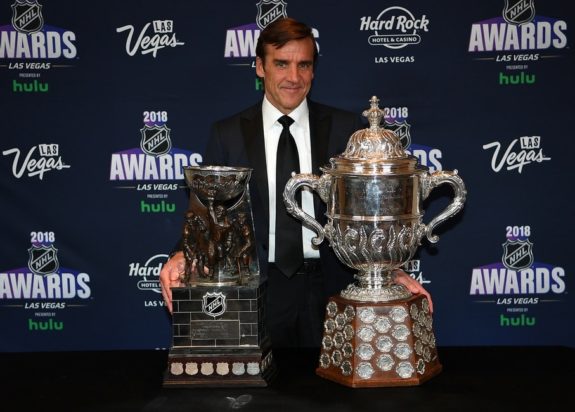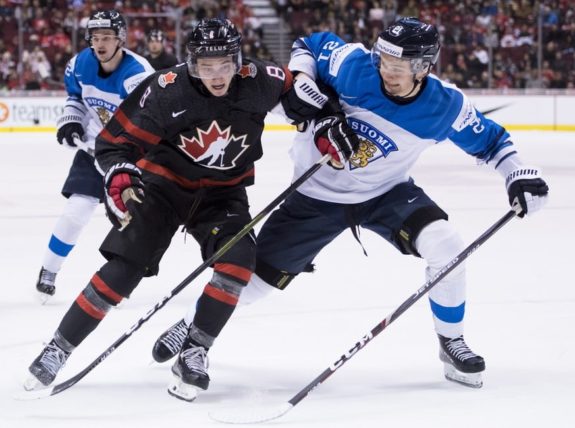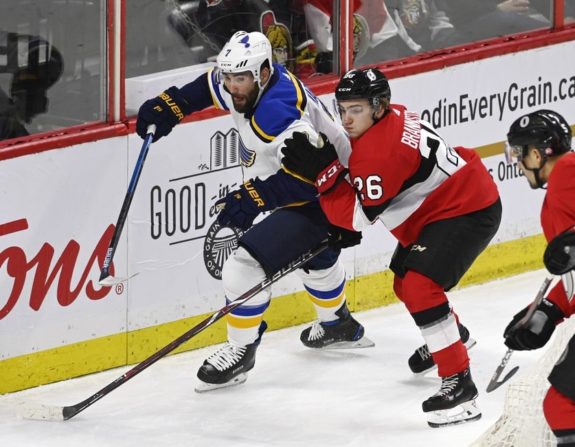Following a trip to the Stanley Cup Final in their inaugural season, the Vegas Golden Knights entered the 2018-19 campaign with big expectations. The team fell short of those expectations after suffering a heartbreaking loss in Game 7 against the San Jose Sharks in the first round. For that reason, along with several others, this offseason will be a crucial one for Vegas’ Stanley Cup chances.
This offseason will be the first under new general manager Kelly McCrimmon. However, former GM George McPhee will remain with the team and in the decision-making process as President of Hockey Operations. The first order of business? Signing one of the team’s best forwards to an extension.

Vegas selected William Karlsson from the Columbus Blue Jackets in the 2017 Expansion Draft and actually got compensated to do so. Karlsson has made a name for himself with the Golden Knights, scoring 67 goals and 134 points in 164 games over the last two seasons. He also notched 20 points during the last two postseasons, including five in 2019. This offseason, he’ll be a restricted free agent who likely stands to earn a pay raise from his current $5.25 million cap hit. Unfortunately, Vegas doesn’t have much wiggle room.
Will Vegas Be Able to Afford Karlsson?
While the NHL’s salary cap is projected to increase to $83 million next season, the Golden Knights have their backs against the wall with the current roster’s cap situation. Several players on the roster will incur a greater cap hit during the 2019-20 campaign than they did this season, including Marc-Andre Fleury, Mark Stone, and Max Pacioretty. With that, Vegas’ projected 2019-20 cap hit sits just under $82 million before re-signing Karlsson or any of the team’s other pending free agents, including Tomas Nosek and Malcolm Subban. However, one thing working in the team’s favor is that Nevada doesn’t charge a state income tax, possibly inclining Karlsson to take a small pay cut.

The first and most likely option to keep salary down will be to promote some young talent from within to fill some roster holes. Fortunately, Vegas has several highly-regarded prospects in its system, including Cody Glass. The sixth-overall pick in 2017, Glass dominated the WHL for seasons before making his AHL debut this season, scoring 10 points in 13 games between the regular season and postseason. There’s a good chance he cracks the lineup with Vegas next season.
The Golden Knights also have a few options to plug holes on the blue line. The 37-year-old Deryk Engelland will be a free agent this offseason, while defensemen such as Nick Holden or Brayden McNabb could be shopped around the trade market as salary dumps. This could open spots at the NHL level for Nicolas Hague, Zach Whitecloud, or Dylan Coghlan. Each of those three young blueliners have impressed at the AHL level and display some offensive upside; especially the 6-foot-6 Hague who was the 34th-overall pick in the 2017 NHL Entry Draft.

Filling roster holes with cheap, young talent will help, but that doesn’t free up enough cash to re-sign their star center. His 134 points over the last two seasons put him 45th in the NHL during that span. To get an idea on what his new contract may look like, some other centers in that general scoring vicinity include Jonathan Toews, Logan Couture, Joe Pavelski, and Ryan O’Reilly. Those players’ salaries ranged from $6 million to $10.5 million this season. While Karlsson may not have as much of a defensive impact as some of those examples, he is the youngest (26 years old) and is signing his deal in an NHL landscape that is seeing larger deals become more common.
How Will Vegas Handle Free Agency?
While Vegas is expected to promote some players from the minor-league system, the team is still looking to compete for a Stanley Cup. Cramming a lineup with young and inexperienced players isn’t the way to do that. In order for the Golden Knight to improve for next season, they’ll need to correct big flaws in other ways.
Their main issue is secondary scoring. During the seven-game series against the Sharks, Vegas scored 25 goals. However, just five of those came from skaters not on a top-six forward line, including two from defensemen. Adding another bottom-six winger will likely be the team’s main focus on the market. After that, they may look at another depth defenseman, assuming that at least one current blueliner gets shipped off.
Obviously, Vegas will set its eyes on relatively low-cost skaters. Some interesting forward options include Micheal Ferland, Pat Maroon, and Richard Panik. Of these options, Maroon will likely be the most affordable. He turned 31 years old in April and scored just 10 goals and 28 points this season after scoring over 40 points in each of the previous two campaigns. Still, he’ll add some goal-scoring touch, a veteran presence, and a physical edge — he’s laid down at least 120 hits in each of the last six seasons — to the bottom-six.

On the defensive side, Vegas wouldn’t aim for a huge splash. A few low-budget options could be Dan Girardi, Jordie Benn, or Ben Chiarot. In an ideal world, Benn would be the pick of this crop. The 6-foot-2 blueliner will turn 32 this offseason but is coming off arguably the best season of his career. He posted career highs with five goals and 22 points alongside a 53.4 Corsi percentage.
What Will the Golden Knights Do With so Many Draft Picks?
It’s not often a contending team enters the offseason with nine picks in the upcoming draft, let alone all those picks being in the first five rounds. Vegas has each of its own picks in those five rounds as well as two extra in the third and fifth rounds. However, it’s hard to see the front office not unloading at least a couple of those.
As mentioned, Vegas will look to free up some cap space this offseason. The easiest way to do that is to trade an unfriendly contract to a team with more space than needed by attaching a draft pick in the deal. Though, while shopping their draft capital, the Golden Knights should keep their first and second round picks to ensure they don’t deplete the prospect pool.
Of course, in a fairly deep draft class, the team will almost certainly look to move up in the draft with its excess capital. Vegas absolutely has the ability to move up in either of the first two rounds or perhaps try to acquire an additional pick in those early rounds.
This offseason is all about balance for the Golden Knights. They’re a contending team for the foreseeable future, but they also have the assets to build a successful team for years to come. While Vegas needs to support its talented roster, the front office has to keep its future in mind and avoid entering a cap nightmare.